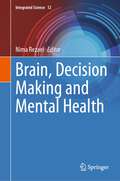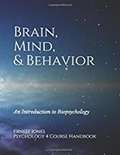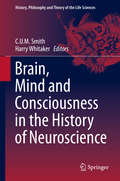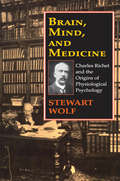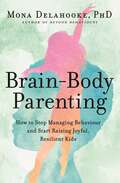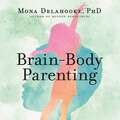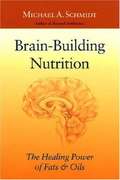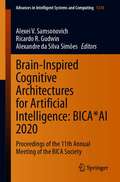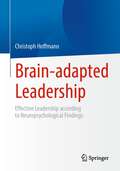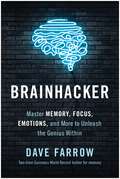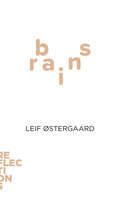- Table View
- List View
Brain and the Inner World: An Introduction to the Neuroscience of Subjective Experience
by Oliver Sacks Mark Solms Oliver TurnbullAbout this Book...The Brain and the Inner World is an eagerly-awaited account of a momentous revolution. Subjective mental states like consciousness, emotion, and dreaming were once confined to the realm of philosophy, psychoanalysis, and the human sciences. These topics now assume center stage in leading neuroscientific laboratories around the world. This shift has produced an explosion of new insights into the natural laws that govern our inner life. By two pioneers in the field, The Brain and the Inner World guides us through the exciting new discoveries, showing how old psychodynamic concepts are being forged into a scientific framework for understanding subjective experience. It is not that the mind is reduced to neurobiology. Rather, thanks to neurobiology, we are free to believe in the power of the mind. The neurosciences will soon be able to argue with Plato, Descartes, James, Freud, and Lacan about the mysterious connections between emotions, experience, will, reason, and creativity.
Brain and the Lexicon: The Neural Basis of Inferential and Referential Competence (Studies in Brain and Mind #15)
by Fabrizio CalzavariniThis monograph offers a novel, neurocognitive theory concerning words and language. It explores the distinction between inferential and referential semantic competence. The former accounts for the relationship of words among themselves, the latter for the relationship of words to the world. The author discusses this distinction at the level of the human brain on both theoretical and neuroscientific grounds. In addition, this investigation considers the relation between the inf/ref neurocognitive theory and other accounts of semantic cognition proposed in the field of neurosemantics, as well as some potential implications of the theory for clinical neuroscience and the philosophy of semantics. Overall, the book offers an important contribution to the debate about lexical semantic competence. It combines a strong philosophical and linguistic background with a comprehensive and critical analysis of neurosemantic literature. Topics discussed lie at the intersection of philosophical semantics, linguistics, neurolinguistics, cognitive science, artificial intelligence, cognitive neuroscience, and clinical psychology. Due to its interdisciplinary orientation, coverage is rich in introductory remarks and not overly technical, therefore it is accessible to non-experts as well.
Brain, Attachment, Personality: An Introduction to Neuroaffective Development
by Susan HartThis book is intended as an inspiration and as an introduction to what Susan Hart has called neuroaffective developmental psychology. As an underlying theme throughout the book, she seeks to emphasize the importance of attachment for the formation of personality in all its diversity. This book presents a merger of systems that are not normally brought together in a structured psychodynamic context. Thus it operates on three levels: a neurobiological level, an intrapsychological level, and an interpersonal level. It also focuses on the brain structures that are essential for the formation of relationships, personality development, and emotions. It attempts to provide an understanding of the way that the uniquely human nervous system develops capacities for empathy, mentalization, and reflection that enable us to address such aspects as: past and present, interpersonal relations, ethics, art, and aesthetics. Susan Hart has endeavoured to make the text meaningful and comprehensible in order to make the topic interesting and inspiring to the reader, and to spark an interest in further studies.
Brain, Behavior and Epigenetics (Epigenetics and Human Health)
by Arturas Petronis Jonathan MillBiomedical research in the first decade of the 21st century has been marked by a rapidly growing interest in epigenetics. The reasons for this are numerous, but primarily it stems from the mounting realization that research programs focused solely on DNA sequence variation, despite their breadth and depth, are unlikely to address all fundamental aspects of human biology. Some questions are evident even to non-biologists. How does a single zygote develop into a complex multicellular organism composed of dozens of different tissues and hundreds of cell types, all genetically identical but performing very different functions? Why do monozygotic twins, despite their stunning external similarities, often exhibit significant differences in personality and predisposition to disease? If environmental factors are solely the cause of such variation, why are similar differences also observed between genetically identical animals housed in a uniform environment? Over the last couple of decades, epigenetics has undergone a significant metamorphosis from an abstract developmental theory to a very dynamic and rapidly developing branch of molecular biology. This volume represents a compilation of our current understanding about the key aspects of epigenetic processes in the brain and their role in behavior. The chapters in this book bring together some of the leading researchers in the field of behavioral epigenetics. They explore many of the epigenetic processes which operate or may be operating to mediate neurobiological functions in the brain and describe how perturbations to these systems may play a key role in mediating behavior and the origin of brain diseases.
Brain, Behaviour and Evolution (Psychology Library Editions: Comparative Psychology)
by David A. Oakley H. C. PlotkinOriginally published in 1979, this book provides students with an example of the ways in which an evolutionary perspective can rephrase and clarify traditional questions and issues in psychology. The format provides the student firstly with the minimal amount of basic information in neuroanatomy, genetics and modern evolutionary theory in a form which is readily related to the remainder of the volume. The book then goes on to consider the relationships between different forms of explanation in biology, and the role of brain behaviour students in these relationships. Finally, the reader is given an opportunity to follow the reasoning which stems from a biological approach when applied to topics in human behaviour such as learning, dreaming, sleeping, exploration, anxiety, reasoning, intelligence and consciousness. Modern evolutionary biology places man in a broader context than does traditional psychology, and this new perspective reduces our tendency to view life solely from a human standpoint. The significance as well as the uniqueness of some traditionally ‘human’ attributes are challenged by this approach.
Brain, Consciousness, and God: A Lonerganian Integration
by Daniel A. HelminiakBrain, Consciousness, and God is a constructive critique of neuroscientific research on human consciousness and religious experience. An adequate epistemology—a theory of knowledge—is needed to address this topic, but today there exists no consensus on what human knowing means, especially regarding nonmaterial realities. Daniel A. Helminiak turns to twentieth-century theologian and philosopher Bernard Lonergan's breakthrough analysis of human consciousness and its implications for epistemology and philosophy of science. Lucidly summarizing Lonergan's key ideas, Helminiak applies them to questions about science, psychology, and religion. Along with Lonergan, eminent theorists in consciousness studies and neuroscience get deserved, detailed attention. Helminiak demonstrates the reality of the immaterial mind and, addressing the Cartesian "mind-body problem," explains how body and mind could make up one being, a person. Human consciousness is presented not only as awareness of objects, but also as self-presence, the self-conscious experience of human subjectivity, a spiritual reality. Lonergan's analyses allow us to say exactly what "spiritual" means, and it need have nothing to do with God.
Brain, Decision Making and Mental Health (Integrated Science #12)
by Nima RezaeiBrain, Decision Making, and Mental Health acknowledges that thinking is not a constant phenomenon but varies considerably across cultures. Critical thinking is particularly important in bridging thinking divisions and its applicability across sciences, particularly medical sciences. We see critical thinking as educable and the arts as means to achieve this purpose. We address the multidimensional relationship between thinking and health and related mechanisms. Thinking mainly affects emotion regulation and executive function; in other words, both mental and physical health are related as a function of thoughts. Considering the thinking‐feeling‐emotion regulation/executive function pathway, it would be reasonable to propose thinking capacities‐based interventions to impact emotion regulation and executive function, such as mindfulness and psychotherapy. We review decision-making taking place in integrated and social contexts and discuss the decision-making styles-decision outcomes relation. Finally, artificial thinking and intelligence prepare us for decision-making outside the human mind.
Brain, Mind & Behavior: An Introduction to Biopsychology (Psychology #4)
by Ernest JonesThis book was created specifically for use in Ernie Jones' Psychology 4 classes at Las Postias College. The lessons of this course are based on the following fundamental principles: 1) Everything you do is a product of brain activity; 2) Brain, Mind and Behavior: A Unified System; and 3) Experience shapes the brain and the brain shapes experience.
Brain, Mind and Consciousness in the History of Neuroscience (History, Philosophy and Theory of the Life Sciences #6)
by C. U. M. Smith Harry WhitakerThis volume of essays examines the problem of mind, looking at how the problem has appeared to neuroscientists (in the widest sense) from classical antiquity through to contemporary times. Beginning with a look at ventricular neuropsychology in antiquity, this book goes on to look at Spinozan ideas on the links between mind and body, Thomas Willis and the foundation of Neurology, Hooke's mechanical model of the mind and Joseph Priestley's approach to the mind-body problem. The volume offers a chapter on the 19th century Ottoman perspective on western thinking. Further chapters trace the work of nineteenth century scholars including George Henry Lewes, Herbert Spencer and Emil du Bois-Reymond. The book covers significant work from the twentieth century, including an examination of Alfred North Whitehead and the history of consciousness, and particular attention is given to the development of quantum consciousness. Chapters on slavery and the self and the development of an understanding of Dualism bring this examination up to date on the latest 21st century work in the field. At the heart of this book is the matter of how we define the problem of consciousness itself: has there been any progress in our understanding of the working of mind and brain? This work at the interface between science and the humanities will appeal to experts from across many fields who wish to develop their understanding of the problem of consciousness, including scholars of Neuroscience, Behavioural Science and the History of Science.
Brain, Mind and Consciousness: Advances in Neuroscience Research
by Petr BobNeuropsychological research on the neural basis of behavior generally asserts that brain mechanisms ultimately suffice to explain all psychologically described phenomena. This assumption stems from the idea that the brain consists entirely of material particles and fields, and that all causal mechanisms relevant to neuroscience can be formulated solely in terms of properties of these elements. Contemporary basic physical theory differs from classic physics on the important matter of how consciousness of human agents enters into the structure of empirical phenomena. The new principles contradict the older idea that local mechanical processes alone account for the structure of all empirical data. Contemporary physical theory brings directly into the overall causal structure certain psychologically described choices made by human agents about how they will act. This key development in basic physical theory is applicable to neuroscience. This book explores this new framework.
Brain, Mind, and Medicine: Charles Richet and the Origins of Physiological Psychology
by Robert GuskindCharles Richet was one of the most remarkable figures in the history of medical science. He is best known for his work on the body's immune reactions to foreign substances for which he won the Nobel Prize in medicine in 1913. Richet was also a poet, playwright, historian, bibliographer, political activist, classical scholar, and pioneer in aircraft design.Brain, Mind, and Medicine is the first major biography of Richet in any language. Wolf brilliantly situates Richet's work in the intellectual currents of Europe during the latter half of the nineteenth and early twentieth century. Richet was a contemporary of Wilhelm Wundt and William James. All three considered psychology to be an aspect of physiology governed by biological laws. But while James and Wundt considered consciousness as a process influenced by experience without much reference to neural structures, Richet's focus was on the brain itself as shaped by genetics and experience and serving as the organ of the mind.Brain, Mind, and Medicine illuminates a significant chapter in scientific and cultural history. It should be read by medical scientists, historians, and individuals interested in medicine and psychology.
Brain, Mind, and the External Signs of Intelligence (Psychology Revivals)
by Bernard HollanderBorn in Vienna in 1864, Bernard Hollander was a London-based psychiatrist. He is best known for being one of the main proponents of phrenology. This title originally published in 1931 looks at the different regions of the brain and their various functions in relation to intelligence. From the preface: "The records of cases collected by the author, including some of his own, point to there being at least three main regions of totally different functions…. Of these three regions, the frontal is by far the largest in man and the most important, being the region for the manifestation of the highest intellectual abilities." Back in print this is a chance to read all about the study of the brain, mind and external signs of intelligence from the early twentieth century.
Brain-Based Learning With Gifted Students: Lessons From Neuroscience on Cultivating Curiosity, Metacognition, Empathy, and Brain Plasticity: Grades 3-6
by Kathryn Fishman-WeaverBrain-Based Learning With Gifted Students combines relevant research in neuroscience with engaging activities for gifted elementary students in grades 3-6. This book:Teaches how development and learning processes happen in the brain.Helps students and teachers explore specific brain-based concepts together.Includes a concise research overview on why each concept works and matters.Offers extension ideas to deepen the activities and strategies for applying each concept to other content areas.Aligns to gifted programming standards.Through the lessons in this book, students will learn how to cultivate curiosity, neuroplasticity, metacognition, empathy, and well-being. Grounded in research on the latest findings in neuroscience, this book empowers gifted education teachers with relevant information on brain-based learning.Grades 3-6
Brain-Based Therapy with Adults: Evidence-Based Treatment for Everyday Practice
by John B. Arden Lloyd LinfordBrain-Based Therapy with Adults: Evidence-Based Treatment for Everyday Practice provides a straightforward, integrated approach that looks at what we currently know about the brain and how it impacts and informs treatment interventions. Authors John Arden and Lloyd Linford, experts in neuroscience and evidence-based practice, reveal how this new kind of therapy takes into account the uniqueness of each client. Presentation of detailed background and evidence-based?interventions for common adult disorders such as anxiety and depression offers you expert advice you can put into practice immediately.
Brain-Based Therapy with Children and Adolescents
by John B. Arden Lloyd LinfordDesigned for mental health professionals treating children and adolescents, Brain-Based Therapy with Children and Adolescents: Evidence-Based Treatment for Everyday Practice is a simple but powerful primer for understanding and successfully implementing the most critical elements of neuroscience into an evidence-based mental health practice. Written for counselors, social workers, psychologists, and graduate students, this new treatment approach focuses on the most common disorders facing children and adolescents, taking into account the uniqueness of each client, while preserving the requirements of standardized care under evidence-based practice.
Brain-Body Parenting: How to Stop Managing Behavior and Start Raising Joyful, Resilient Kids
by Mona DelahookeFrom a leading child psychologist comes this groundbreaking new understanding of children’s behavior, offering insight and strategies to support both parents and children.Over her decades as a clinical psychologist, Dr. Mona Delahooke has routinely counseled distraught parents who struggle to manage their children’s challenging, sometimes oppositional behaviors. These families are understandably focused on correcting or improving a child’s lack of compliance, emotional outbursts, tantrums, and other “out of control” behavior. But, as she has shared with these families, a perspective shift is needed. Behavior, no matter how challenging, is not the problem but a symptom; a clue about what is happening in a child’s unique physiologic makeup. In Brain-Body Parenting, Dr. Delahooke offers a radical new approach to parenting based on her clinical experience as well as the most recent research in neuroscience and child psychology. Instead of a “top-down” approach to behavior that focuses on the thinking brain, she calls for a “bottom-up” approach that considers the essential role of the entire nervous system, which produces children’s feelings and behaviors.When we begin to understand the biology beneath the behavior, suggests Dr. Delahooke, we give our children the resources they need to grow and thrive—and we give ourselves the gift of a happier, more connected relationship with them. Brain-Body Parenting empowers parents with tools to help their children develop self-regulation skills while also encouraging parental self-care, which is crucial for parents to have the capacity to provide the essential “co-regulation” children need. When parents shift from trying to secure compliance to supporting connection and balance in the body and mind, they unlock a deeper understanding of their child, encouraging calmer behavior, more harmonious family dynamics, and increased resilience.
Brain-Body Parenting: How to Stop Managing Behaviour and Start Raising Joyful, Resilient Kids
by Mona Delahooke'I will be recommending this book to every parent' Dr Laura Markham'I adore this book!' Dr Tina Payne BrysonOver her decades as a clinical psychologist, Dr Mona Delahooke has helped countless distraught parents who struggle to manage their children's challenging behaviours. These families are understandably focused on correcting or improving a child's lack of compliance, emotional outbursts, tantrums and other 'out of control' behaviour. But behaviour, no matter how challenging, is not the problem but a symptom; a clue about what is happening in a child's unique physiological makeup.In Brain-Body Parenting, Dr Delahooke offers a radical new approach to parenting based on an approach that considers the essential role of the entire nervous system, which produces children's feelings and behaviours.When we begin to understand the biology beneath the behaviour, suggests Dr Delahooke, we give our children the resources they need to grow and thrive, and we give ourselves the gift of a happier, more connected relationship with them. Brain-Body Parenting empowers parents with tools to help their children develop self-regulation skills, while also encouraging parental self-care. The result is a deeper understanding of your child, encouraging calmer behaviour, more harmonious family dynamics, and increased resilience.
Brain-Body Parenting: How to Stop Managing Behaviour and Start Raising Joyful, Resilient Kids
by Mona Delahooke'I will be recommending this book to every parent' Dr Laura Markham'I adore this book!' Dr Tina Payne BrysonOver her decades as a clinical psychologist, Dr Mona Delahooke has helped countless distraught parents who struggle to manage their children's challenging behaviours. These families are understandably focused on correcting or improving a child's lack of compliance, emotional outbursts, tantrums and other 'out of control' behaviour. But behaviour, no matter how challenging, is not the problem but a symptom; a clue about what is happening in a child's unique physiological makeup.In Brain-Body Parenting, Dr Delahooke offers a radical new approach to parenting based on an approach that considers the essential role of the entire nervous system, which produces children's feelings and behaviours.When we begin to understand the biology beneath the behaviour, suggests Dr Delahooke, we give our children the resources they need to grow and thrive, and we give ourselves the gift of a happier, more connected relationship with them. Brain-Body Parenting empowers parents with tools to help their children develop self-regulation skills, while also encouraging parental self-care. The result is a deeper understanding of your child, encouraging calmer behaviour, more harmonious family dynamics, and increased resilience.
Brain-Building Nutrition: How Dietary Fats and Oils Affect Mental, Physical, and Emotional Intelligence
by Michael SchmidtThis provides a host of practical dietary information and new, groundbreaking research to support the author's findings. A remarkable but little known fact is that the brain is nearly 60 percent fat.
Brain-Changing Strategies to Trauma-Proof Our Schools: A Heart-Centered Movement for Wiring Well-Being
by Maggie KlineStop trauma in its tracks, address disruptive behaviors, and create a safe and nurturing school environment with a neuroscience-based approach in your classroom.More than 32 million children in the US suffer from trauma symptoms. Some have had adverse childhood experiences (ACEs), like neglect, abuse, violence, and loss, or have experienced distress from medical trauma and social injustice. Toxic traumatic stress shapes the structure and function of both brain and body, which can lead to anxiety, hyperactivity, aggression, shutting down, and acting out--emotions and behaviors that hinder learning and create classroom chaos. Maggie Kline, a family therapist, trauma specialist, school psychologist, and former teacher, gives you whole-brain, heart-centered tools to identify and reverse trauma-driven behaviors so students feel supported and safe. Her unique roadmap will empower you to facilitate positive school-wide outcomes as you learn: • How trauma alters kids' brains causing cognitive, emotional, and behavioral challenges • Evidence-based somatic, relational, and mindfulness interventions to rewire reactivity • How to manage Pre-K-12 classrooms to promote empathy, cooperation, and belonging • Social equity practices so kids from all backgrounds feel safe, valued, and joyful • Concrete steps to restore resilience following natural and man-made catastrophes
Brain-Inspired Cognitive Architectures for Artificial Intelligence: Proceedings of the 11th Annual Meeting of the BICA Society (Advances in Intelligent Systems and Computing #1310)
by Alexei V. Samsonovich Ricardo R. Gudwin Alexandre da Silva SimõesThe book focuses on original approaches intended to support the development of biologically inspired cognitive architectures. It bridges together different disciplines, from classical artificial intelligence to linguistics, from neuro- and social sciences to design and creativity, among others. The chapters, based on contributions presented at the Eleventh Annual Meeting of the BICA Society, held on November 10-14, 2020, in Natal, Brazil, discuss emerging methods, theories and ideas towards the realization of general-purpose humanlike artificial intelligence or fostering a better understanding of the ways the human mind works. All in all, the book provides engineers, mathematicians, psychologists, computer scientists and other experts with a timely snapshot of recent research and a source of inspiration for future developments in the broadly intended areas of artificial intelligence and biological inspiration.
Brain-adapted Leadership: Effective Leadership according to Neuropsychological Findings
by Christoph HoffmannThe book shows you how you can effectively integrate the latest findings of neuroscience into your everyday work or leadership. Brain-adapted leadership shows you how applied psychology from the perspective of neuroscience works both in leadership work and in everyday professional life as a whole. Based on a neuropsychological behavioral model, you will learn about the plausible connections between perceptions, needs, emotions, thinking and acting. These insights form a valuable basis for leading yourself, teams and corporate units. In addition, you will receive numerous exercise instructions and examples for illustration and practical implementation. The subject of this work is of particular importance to you if you want to better understand your own feelings and behavior and those of your fellow human beings in order to achieve valuable interactions and fulfilling work activities. Target Audience:This reference book is aimed at managers and coaches, as well as people in the world of work who are willing to work on themselves to achieve greater satisfaction, serenity and balance: and neuroscience knows that we can do this, even into old age. About the author: Christoph Hoffmann is a graduate psychologist FH, graduate engineer HTL; studied psychology with a focus on Industrial and Organizational Psychology in Zurich. He has leadership experience in various adult education institutions and works at the IAP at the ZHAW Zurich University of Applied Sciences as a consultant and lecturer in the Centre for Leadership, Coaching and Change Management.
Brain2Brain
by John B. ArdenOvercome resistance and fully engage clients by bringing neuroscience into treatmentBrain2Brain: Enacting Client Change Through the Persuasive Power of Neuroscience applies the popular topic of neuroscience in mental health to everyday practice, showing therapists how to teach their clients brain-based strategies for making changes and improving their lives. Cutting-edge findings in neuroscience are translated into language that clients will understand, and sidebars provide therapists more detailed information relating to particular disorders. With a holistic approach that incorporates mental, spiritual, and physical skills, knowledge, and exercises, this book provides a clear, complete resource for incorporating neuroscience into therapy. Case examples illustrate how the material can be used with different types of clients and situations, and sample dialogues and client handouts help therapists easily incorporate these techniques into their practice.Many clients forget that there is a biological basis for everything the brain does, and the ways that activity manifests everyday - good or bad, healthy or dysfunctional, the very core of human consciousness boils down to a series of electrical impulses. This book helps therapists bring neuroscience into therapy, to teach clients how to work with their brain's innate processes to reinforce progress and achieve healthier outcomes.Learn techniques for dealing with client resistance factorsDiscover phrases and memory aides that help clients apply what they've learned in therapyFacilitate higher client motivation to engage in the therapeutic processTeach clients about the brain's relevance to their particular problemFind tools for explaining the role of diet, exercise, and sleep in mental healthWhen a client's treatment revolves around eliminating harmful thought patterns or behaviors, the therapeutic process can feel like a battle against their own brain. By bringing neuroscience into the treatment plan, therapists can shift the client's perspective to a more collaborative mindset, focused on the positive aspects of change. Brain2Brain: Enacting Client Change Through the Persuasive Power of Neuroscience provides the guidance therapists need to chart a clearer path to good mental health.
Brainhacker: Master Memory, Focus, Emotions, and More to Unleash the Genius Within
by Dave FarrowIf you feel like your brain is &“glitching,&” or working against you, know that you&’re not stuck with the brain biology gave you. An upgrade is possible. In Brainhacker, you&’ll learn how to &“rewire&” your brain and boost its power. David Farrow, author of The Farrow Method, helps you get inside your own head and call the shots, with concrete exercises and tips to train your brain to work for you. These tricks can instantly boost your memory, improve your reading speed, help you push away pain, and form life-changing habits that actually last—with techniques as simple as a hand movement or a little bit of imagination. Farrow speaks from personal experience. His unlikely journey from underachieving kid with ADHD and dyslexia to winner of multiple Guinness World Records for memorization is proof that training your brain really works—and can unlock hidden potential. Brainhacker pairs Farrow&’s unique, tried-and-true methods with his own story, following his path to success as he searched for solutions to overcome his struggles with focus, memory, sleep, anxiety, self-esteem, and more. On average, we waste 40 days of the year compensating for our bad memory. Many of us suffer from insomnia, stress, and chronic pain. The COVID-19 pandemic has caused a huge surge in the already-huge number of people suffering from burnout and mental health problems. But all of this, from memory to ADHD symptoms to sleep problems, can be transformed with the simple hacks you&’ll find in these pages. If you&’re ready to tap into the full power of your brain, Brainhacker is your all-in-one guide to hacking into your brain—and making it as powerful as it can be.
Brains
by Leif ØstergaardA short but engaging exploration of the brain.In Brains, scientist Leif Østergaard explores our most complicated and mysterious organ. From the dissection of Einstein's brain to research on how to map networks of neurons, Østergaard deconstructs the different parts of the brain and provides an engaging overview of its essential functions. He explains how we store information in the synapses of neural networks and how these networks carry commands to our muscles and internal organs and receive sensory input from our skin, eyes, ears, nose, and mouth. Delving into the subconscious, we learn what our brains are doing while we daydream and how neurotransmitters play a role in addiction. In this fascinating book, Østergaard reveals how this enigmatic organ is even more complex than we thought it was.In Reflections, a series copublished with Denmark's Aarhus University Press, scholars deliver 60-page reflections on key concepts. These books present unique insights on a wide range of topics that entertain and enlighten readers with exciting discoveries and new perspectives.






